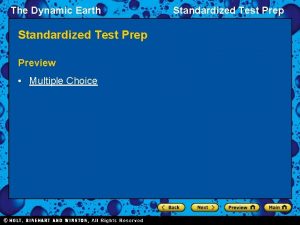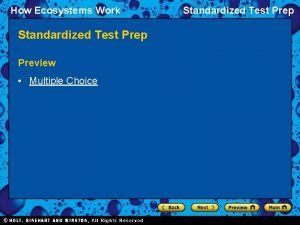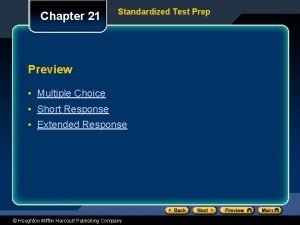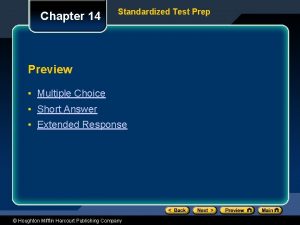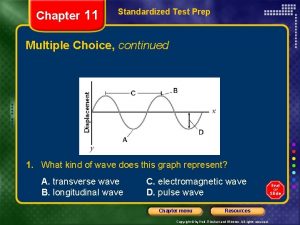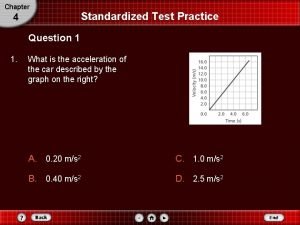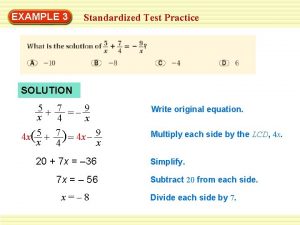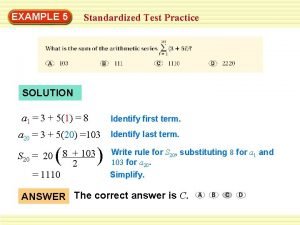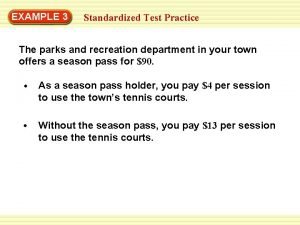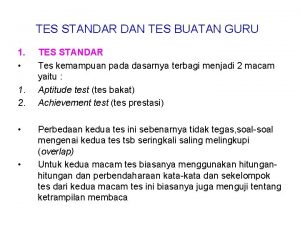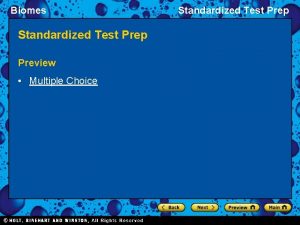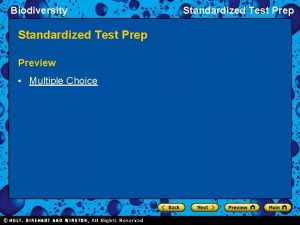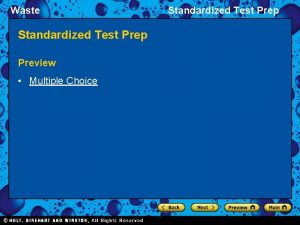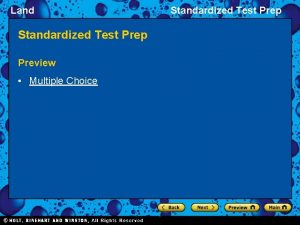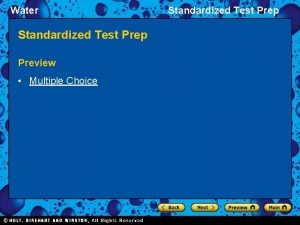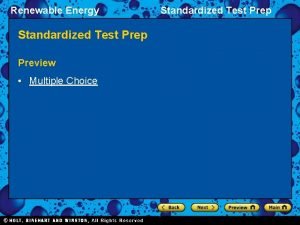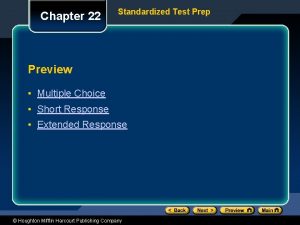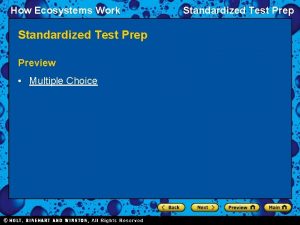The Dynamic Earth Standardized Test Prep Preview Multiple
















- Slides: 16

The Dynamic Earth Standardized Test Prep Preview • Multiple Choice Standardized Test Prep

The Dynamic Earth Standardized Test Prep Multiple Choice 1. What is the cool, rigid, outermost layer of the Earth? A. the asthenosphere B. the geosphere C. the lithosphere D. the mesosphere

The Dynamic Earth Standardized Test Prep Multiple Choice 1. What is the cool, rigid, outermost layer of the Earth? A. the asthenosphere B. the geosphere C. the lithosphere D. the mesosphere

The Dynamic Earth Standardized Test Prep Multiple Choice, continued 2. The collision of tectonic plates creates what geologic feature? F. earthquakes G. faults H. mountains I. volcanoes

The Dynamic Earth Standardized Test Prep Multiple Choice, continued 2. The collision of tectonic plates creates what geologic feature? F. earthquakes G. faults H. mountains I. volcanoes

The Dynamic Earth Standardized Test Prep Multiple Choice, continued 3. What determines the weather we experience on Earth? A. movement of water over land masses B. gases trapping heat near Earth’s surface C. absorption of radiation by thermosphere D. air constantly moving through Earth’s atmosphere

The Dynamic Earth Standardized Test Prep Multiple Choice, continued 3. What determines the weather we experience on Earth? A. movement of water over land masses B. gases trapping heat near Earth’s surface C. absorption of radiation by thermosphere D. air constantly moving through Earth’s atmosphere

The Dynamic Earth Standardized Test Prep Multiple Choice, continued 4. What is the difference between evaporation and condensation? F. Evaporation is the first stage of the water cycle; condensation is the last stage. G. Evaporation is the change from water to vapor; condensation is the change from vapor to water. H. Evaporation is the process where water is heated by the sea; condensation is the process where water droplets fall from clouds. I. Evaporation is the process where water vapor forms droplets; condensation is the process where water vapor forms clouds.

The Dynamic Earth Standardized Test Prep Multiple Choice, continued 4. What is the difference between evaporation and condensation? F. Evaporation is the first stage of the water cycle; condensation is the last stage. G. Evaporation is the change from water to vapor; condensation is the change from vapor to water. H. Evaporation is the process where water is heated by the sea; condensation is the process where water droplets fall from clouds. I. Evaporation is the process where water vapor forms droplets; condensation is the process where water vapor forms clouds.

The Dynamic Earth Standardized Test Prep Multiple Choice, continued 5. Which of the following statements is true? A. The world ocean covers 70% of Earth’s surface. B. The world ocean is the body of water south of Africa. C. The world ocean has little effect on Earth’s environment. D. The world ocean consists of the Atlantic and Pacific Oceans.

The Dynamic Earth Standardized Test Prep Multiple Choice, continued 5. Which of the following statements is true? A. The world ocean covers 70% of Earth’s surface. B. The world ocean is the body of water south of Africa. C. The world ocean has little effect on Earth’s environment. D. The world ocean consists of the Atlantic and Pacific Oceans.

The Dynamic Earth Standardized Test Prep Multiple Choice, continued Use this map to answer question 6.

The Dynamic Earth Standardized Test Prep Multiple Choice, continued 6. What determines the salinity of the ocean’s water? F. chlorine G. chlorine and sulfur H. sodium I. sodium and chlorine

The Dynamic Earth Standardized Test Prep Multiple Choice, continued 6. What determines the salinity of the ocean’s water? F. chlorine G. chlorine and sulfur H. sodium I. sodium and chlorine

The Dynamic Earth Standardized Test Prep Multiple Choice, continued 7. The Atlantic Ocean covers 81, 630, 000 km 2 of Earth’s surface area and the Pacific Ocean covers 165, 640, 000 km 2. How much more surface area is covered by the Pacific Ocean the Atlantic Ocean, in millions of km 2? A. 72 B. 84 C. 96 D. 108

The Dynamic Earth Standardized Test Prep Multiple Choice, continued 7. The Atlantic Ocean covers 81, 630, 000 km 2 of Earth’s surface area and the Pacific Ocean covers 165, 640, 000 km 2. How much more surface area is covered by the Pacific Ocean the Atlantic Ocean, in millions of km 2? A. 72 B. 84 C. 96 D. 108
 Test prep preview
Test prep preview Test prep preview
Test prep preview Test prep preview
Test prep preview Test prep preview
Test prep preview Test prep preview
Test prep preview Chapter 21 standardized test practice answers
Chapter 21 standardized test practice answers Test prep preview
Test prep preview Test prep preview
Test prep preview Circuit training standardized test prep answers
Circuit training standardized test prep answers Chapter 13 standardized test prep answers
Chapter 13 standardized test prep answers 10-6 standardized test prep answers
10-6 standardized test prep answers 4 standardized test practice answers
4 standardized test practice answers 7-3 standardized test prep
7-3 standardized test prep Extraneous solution definition
Extraneous solution definition 5-1 standardized test prep
5-1 standardized test prep 3-5 standardized test prep
3-5 standardized test prep Contoh tes standar
Contoh tes standar
